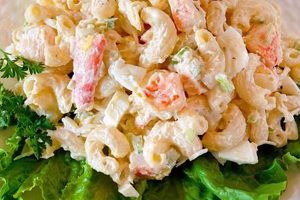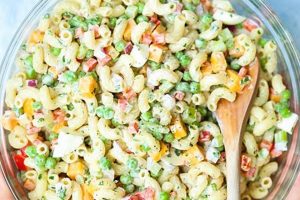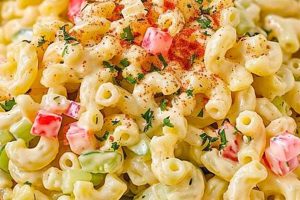A chilled dish featuring cooked elbow macaroni, peas, and often other vegetables like celery, onions, and pimentos, bound together by mayonnaise or a similar creamy dressing, typifies this culinary creation. Variations can include hard-boiled eggs, cheese, or different protein additions like ham or tuna. A simple version might consist of macaroni, peas, mayonnaise, celery, and onion, seasoned with salt and pepper.
This type of dish offers a convenient and refreshing meal, particularly suitable for warm weather or potlucks. Its adaptability allows for numerous variations to cater to diverse palates and dietary preferences. Historically, such pasta salads gained popularity with the rise of refrigeration and the increasing availability of prepared ingredients like mayonnaise. The ease of preparation and transport contributed to their frequent appearance at picnics, barbecues, and social gatherings.
Further exploration could delve into specific ingredient selections, diverse dressing options, techniques for achieving optimal texture and flavor, and creative variations on the classic formulation.
Tips for an Excellent Macaroni Pea Salad
Achieving a well-balanced and flavorful dish requires attention to detail. The following tips offer guidance for optimal results.
Tip 1: Cook Macaroni Properly. Slightly firm, al dente pasta provides the best texture. Overcooked macaroni can result in a mushy salad. Follow package directions, reducing cooking time slightly for optimal firmness.
Tip 2: Chill Ingredients Thoroughly. Cold ingredients ensure food safety and enhance the refreshing quality of the salad. Chill cooked macaroni, peas, and other vegetables before combining with the dressing.
Tip 3: Balance Flavors. A harmonious blend of savory and tangy elements is key. Consider the acidity of the dressing and balance it with the sweetness of peas or other additions like chopped red onion.
Tip 4: Choose High-Quality Mayonnaise. The base of the dressing significantly impacts the overall flavor. Select a mayonnaise with a good balance of richness and tang.
Tip 5: Season Appropriately. Salt and pepper are essential, but other seasonings can elevate the flavor profile. Consider using Dijon mustard, celery seed, or fresh herbs.
Tip 6: Don’t Overdress. Too much dressing can make the salad heavy and mask the flavor of the other ingredients. Start with a smaller amount of dressing and add more as needed to achieve the desired consistency.
Tip 7: Allow Flavors to Meld. Chilling the salad for at least 30 minutes before serving allows the flavors to blend and develop depth.
Attention to these details ensures a delicious and satisfying result. By focusing on quality ingredients, proper cooking techniques, and balanced flavors, one can create a memorable dish.
With these tips in mind, exploration of specific recipe variations and creative adaptations becomes the next logical step.
1. Ingredients
Ingredient selection significantly impacts the final character of a macaroni pea salad. The interplay of textures and flavors determines whether the result is a refreshing, balanced dish or a bland, unappetizing one. Consider the textural contrast between firm, al dente pasta and tender peas. This textural diversity is essential for a pleasant eating experience. Further textural interest can be added through crisp vegetables like celery or bell peppers. Flavor profiles are equally important. The inherent sweetness of peas requires a complementary tang, often provided by mayonnaise, vinegar, or a combination thereof. The choice of additional ingredients, such as red onion for sharpness or cheddar cheese for richness, further shapes the overall taste profile.
Practical examples illustrate this connection. Using frozen peas rather than canned improves both texture and flavor, avoiding the mushiness sometimes associated with canned varieties. Similarly, opting for high-quality mayonnaise rather than a generic brand significantly enhances the richness and overall flavor of the dressing. Selecting fresh herbs, like dill or chives, over dried versions introduces a brighter, more nuanced flavor dimension. These seemingly small decisions cumulatively contribute to a superior final product.
Understanding the importance of ingredient selection empowers one to create a macaroni pea salad that transcends mere sustenance. By carefully considering the interplay of textures, flavors, and aromas, this simple dish can become a culinary highlight. The thoughtful selection of each component, from the type of pasta to the seasonings used, ultimately determines the success of the final creation. Careful consideration of these factors ensures a dish that is not only visually appealing but also delivers a complex and satisfying sensory experience.
2. Proportions
Proportions play a crucial role in determining the success of a macaroni pea salad recipe. The balance between pasta, vegetables, and dressing dictates the overall texture and flavor profile. An excess of dressing can result in a heavy, soggy salad, while too little dressing leads to a dry, unappetizing outcome. Similarly, an imbalance between the pasta and vegetables can affect the perceived flavor complexity. A salad dominated by pasta might lack the textural and flavorful nuances provided by the vegetables, while an overabundance of vegetables can overshadow the other components.
Consider a scenario where the recipe calls for one cup of cooked macaroni, one cup of peas, and half a cup of mayonnaise-based dressing. This ratio ensures that each element contributes appropriately to the overall dish. The pasta provides a substantial base, the peas offer sweetness and texture, and the dressing binds the ingredients together while adding richness and tang. Deviating significantly from these proportions can compromise the balance. For example, using two cups of pasta with the same amount of peas and dressing would result in a bland, pasta-heavy salad. Conversely, increasing the peas to two cups might overwhelm the other ingredients, resulting in a salad that lacks cohesion.
Understanding the importance of proportions empowers one to adjust a recipe to suit individual preferences while maintaining a harmonious balance. While a classic recipe provides a good starting point, recognizing the impact of ingredient ratios allows for customization. Perhaps a preference for a creamier salad necessitates a slight increase in the dressing, or a desire for a more pronounced vegetable presence requires adjusting the quantity of peas or other vegetables. However, these adjustments should be made thoughtfully, keeping in mind the delicate balance that defines a successful macaroni pea salad. Ultimately, mastering the art of proportions elevates this simple dish from a basic combination of ingredients to a carefully crafted culinary creation.
3. Preparation method
Preparation methods significantly influence the final quality of macaroni pea salad. Careful attention to each step, from cooking the pasta to incorporating the dressing, ensures optimal texture and flavor. Overcooked macaroni results in a mushy salad lacking textural appeal. Conversely, undercooked pasta offers an unpleasant firmness. The cooking process itself requires precise timing and attention to the manufacturer’s instructions, often adjusted based on desired firmness. Proper draining and rinsing prevent residual starch from creating a sticky, gluey consistency. Similarly, chilling the cooked pasta promptly arrests the cooking process and maintains the desired texture. These seemingly minor details contribute significantly to the overall success of the dish.
Consider the impact of dressing incorporation. Adding the dressing while the pasta is still warm can lead to absorption and a less distinct flavor profile. Chilling the pasta thoroughly before combining it with the dressing allows the flavors to remain distinct and vibrant. Further, the gentle folding method employed during dressing incorporation prevents the delicate pasta from breaking down, preserving the visual appeal of the salad. These nuanced techniques underscore the critical relationship between preparation method and final outcome. A rushed or careless approach can compromise the integrity of the dish, resulting in a subpar culinary experience. Conversely, a meticulous approach, grounded in an understanding of these cause-and-effect relationships, elevates the simple macaroni pea salad to a higher level of culinary refinement.
Mastering the appropriate preparation methods ensures a macaroni pea salad that is not only visually appealing but also texturally and flavorfully satisfying. These techniques, while seemingly straightforward, require attention and understanding. The ultimate success of the dish hinges on the careful execution of each step, highlighting the integral role of preparation in achieving culinary excellence. This attention to detail transforms a basic recipe into a carefully orchestrated culinary creation.
4. Flavor Balance
Flavor balance represents a critical aspect of a successful macaroni pea salad recipe. Achieving a harmonious blend of tastes elevates this simple dish from ordinary to exceptional. The interplay of sweet, savory, tangy, and creamy elements determines the overall sensory experience. A well-balanced salad offers a complex flavor profile that engages the palate, while an unbalanced salad can be bland or, conversely, overwhelming.
- Sweetness from Peas
The inherent sweetness of peas provides a foundational flavor element. This sweetness requires careful balancing with other flavors to prevent the salad from tasting overly saccharine. The sweetness of frozen peas, typically picked at peak ripeness, tends to be more pronounced than that of canned peas. This difference necessitates adjustments in the other ingredients, potentially requiring a more assertive tangy component to achieve balance.
- Tanginess from the Dressing
The dressing provides the primary source of tanginess, typically achieved through ingredients like mayonnaise, vinegar, or lemon juice. This acidity cuts through the richness of the mayonnaise and the sweetness of the peas, creating a more balanced flavor profile. The specific type of vinegar used, whether apple cider vinegar or white wine vinegar, introduces subtle flavor nuances that further influence the overall balance. The amount of vinegar or lemon juice must be carefully calibrated to avoid an excessively tart result.
- Savory Notes from Aromatics and Add-ins
Savory elements, often contributed by ingredients like celery, onion, or hard-boiled eggs, add depth and complexity to the flavor profile. These ingredients provide a counterpoint to the sweetness and tanginess, creating a more well-rounded taste experience. The choice of specific aromatics, such as red onion versus scallions, introduces distinct flavor nuances that influence the overall balance. Other add-ins, like crumbled bacon or chopped ham, introduce additional savory notes that must be integrated into the overall flavor profile.
- Creaminess from the Base
The creamy element, typically provided by mayonnaise, contributes richness and texture. This creaminess, while essential for binding the ingredients and providing a smooth mouthfeel, requires careful management to avoid an overly heavy or greasy result. Using a lighter mayonnaise, or incorporating Greek yogurt for a tangier, less rich option, can impact the overall balance and create a lighter, more refreshing salad. This element plays a crucial role in harmonizing the various flavor components.
These four facets of flavorsweetness, tanginess, savoriness, and creaminessintertwine to create the overall flavor profile of a macaroni pea salad. Careful consideration of each element and its interaction with the others ensures a balanced and enjoyable culinary experience. The precise balance of these components distinguishes a truly exceptional salad from a mediocre one. Mastering this balance elevates the dish from a simple side to a nuanced culinary creation.
5. Serving Suggestions
Serving suggestions enhance the enjoyment and versatility of macaroni pea salad, transforming it from a simple side dish to a star component of various meal occasions. Consideration of serving suggestions demonstrates an understanding of the dish’s role within a larger culinary context. Thoughtful presentation and pairings elevate the perceived value and overall appeal. The practical application of this understanding lies in the ability to adapt the salad to different settings and preferences.
For instance, a classic presentation involves serving the salad chilled as a side dish alongside grilled meats or sandwiches at a barbecue. This approach highlights the salad’s refreshing qualities and complements the richness of the main course. Alternatively, a more substantial presentation might incorporate grilled chicken or tuna into the salad itself, transforming it into a complete, protein-rich meal suitable for a light lunch or dinner. Serving the salad in individual portions, such as in small bowls or on lettuce cups, adds an element of elegance to a buffet or picnic setting. These diverse serving suggestions illustrate the adaptability of macaroni pea salad and its potential to cater to a variety of culinary needs. The adaptability underscores its practical value as a versatile dish.
Effective serving suggestions maximize the appeal of macaroni pea salad. Understanding the context in which the salad will be served allows for strategic choices in presentation and accompaniments. Whether presented as a simple side or a more complex main course, careful consideration of serving suggestions ensures that macaroni pea salad contributes positively to the overall dining experience. This attention to detail distinguishes a truly thoughtful and satisfying culinary presentation. The ultimate goal is to enhance the enjoyment and appreciation of this versatile dish.
Frequently Asked Questions
This section addresses common inquiries regarding macaroni pea salad preparation, offering practical solutions and clarifying potential misconceptions.
Question 1: How can one prevent macaroni pea salad from becoming watery?
Excess moisture often stems from insufficiently drained pasta or watery vegetables. Thoroughly draining the cooked macaroni and using frozen peas (thawed and patted dry) rather than canned peas helps mitigate this issue. Additionally, chilling all ingredients before combining them with the dressing minimizes moisture release.
Question 2: What are suitable alternatives to mayonnaise in the dressing?
Greek yogurt offers a lighter, tangier alternative to mayonnaise. Alternatively, a vinaigrette dressing using olive oil, vinegar, and herbs can create a lighter, more refreshing salad. Combining a smaller amount of mayonnaise with plain yogurt also provides a compromise between richness and reduced fat content.
Question 3: How long can macaroni pea salad be stored safely?
Refrigerated in an airtight container, the salad typically remains safe for consumption for three to five days. However, the presence of ingredients like hard-boiled eggs or meat might reduce this timeframe. Always prioritize food safety guidelines.
Question 4: Can this salad be prepared in advance for a potluck or picnic?
Advance preparation is certainly feasible. Prepare the salad up to 24 hours in advance, storing it chilled in an airtight container. This allows the flavors to meld, enhancing the overall taste experience.
Question 5: How can one enhance the flavor profile beyond basic seasonings?
Fresh herbs like dill, chives, or parsley add brightness and complexity. Incorporating chopped red onion or a dash of Dijon mustard introduces a pleasant sharpness. Crumbled bacon or diced ham provides a savory dimension. Experimentation with various spices and seasonings allows for customization.
Question 6: What are effective strategies for achieving optimal pasta texture?
Cooking the pasta al dente, slightly firm to the bite, is crucial. Follow package directions, reducing cooking time slightly to achieve the desired firmness. Immediately rinsing the cooked pasta under cold water stops the cooking process and helps maintain its texture. These steps prevent overcooked, mushy pasta, ensuring a pleasant textural experience.
Addressing these common concerns facilitates successful preparation and enjoyment. A thorough understanding of these considerations ensures optimal results and reduces the likelihood of culinary mishaps.
Further exploration might delve into specific recipe variations and creative adaptations. Experimentation with ingredients and flavors allows for personalized interpretations of this classic dish.
Macaroni Pea Salad Recipe
Exploration of the macaroni pea salad recipe reveals a dish greater than the sum of its parts. Careful consideration of ingredients, proportions, preparation methods, and flavor balance elevates this seemingly simple preparation to a nuanced culinary experience. From the selection of fresh, high-quality ingredients to the precise execution of cooking techniques, each step contributes to the final outcome. Understanding the interplay of textures and flavorsthe sweetness of peas, the tang of the dressing, the savoriness of added aromaticsempowers culinary creativity and ensures a well-balanced, satisfying dish.
Macaroni pea salad, adaptable and versatile, lends itself to endless variations. Further experimentation promises continued culinary discovery. Whether served as a refreshing side dish or a more substantial main course, its enduring appeal lies in its ability to satisfy a variety of palates and occasions. This exploration encourages thoughtful engagement with recipe development and highlights the potential for culinary artistry within even the most familiar dishes.






